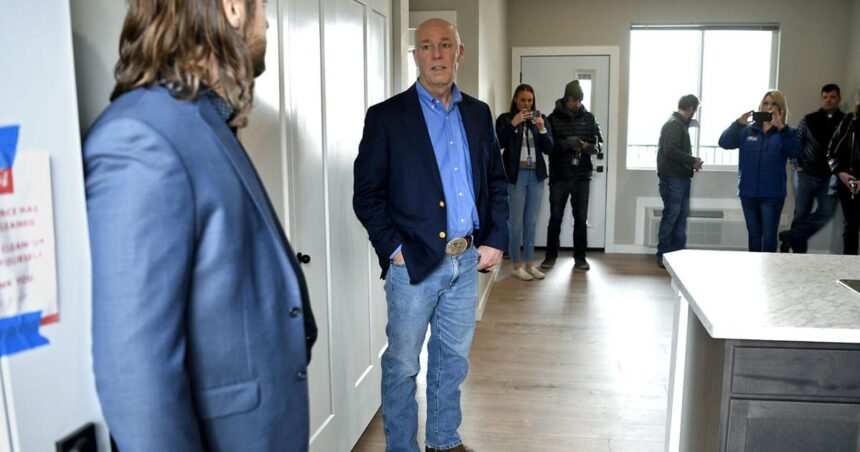The Montana Housing Task Force delivered its third set of policy recommendations to Gov. Greg Gianforte on Wednesday, and the document calls for measures like limiting subdivision approval conditions and setting reasonable limits on impact fees.
A total of 23 different recommendations, which would have to be implemented as bills in the Montana Legislature and approved by the governor, are in the document which is online at deq.mt.gov/about/Housing-Task-Force under the Phase III section.
Gianforte praised the bipartisan cooperation of the Housing Task Force, which has previously submitted two other recommendation reports. Some of those recommendations have been implemented as law and some were not in the last session. A few recommendations have been challenged in court.
People are also reading…
The Montana Housing Task Force delivered its third set of policy recommendations to Gov. Greg Gianforte on Wednesday, and the document calls for measures like limiting subdivision approval conditions and setting reasonable limits on impact fees.
Gianforte said that over the last decade, Montana’s population has grown by 10% while the number of housing starts in the same time period has grown by only 7%, leading to a shortage of homes and rising prices.
“We all have an obligation to solve this problem,” Gianforte said. “Owning a home is foundational to the American dream. And for at least the last 12 years, owning a home has gotten more difficult.”
Gianforte said that the laws passed in the most recent session were a great start, and he noted that at least one national publication called it the “Montana Miracle.” He also noted that Zillow rental market data recently showed that the median rental price in Missoula has dropped by over $400 annually in 2024 compared to last year.
Still, he said, there’s a lot more work to be done.
The first recommendation in the most recent document is to eliminate minimum lot size and lot width requirements in cities to facilitate starter home construction with less expensive detached single-family houses and townhouses. The report noted that places that have implemented that change, such as Houston, Texas, have seen a marked increase in starter home construction.
“A 2021 University of Montana report found minimum lot sizes raise housing prices by as much as 20% by forcing buyers to purchase more land than they want,” the report states. “Several additional studies have confirmed this finding. The City of Bozeman 2021 Development Code Audit for Affordable Housing notes that additional-lot-area-per-unit standards are a significant contributor to high housing prices for non-single-household development.”
Each recommendation comes with a dissenting opinion, with many of the dissenting opinions stating that the Montana Land Use and Planning Act, which was signed into law this year but is currently being challenged in court, should be allowed to stand because it preserves “local control.”
Todd O’Hair, the executive director of the Montana Chamber of Commerce, said high housing costs are stifling the economy in the state.
Gov. Greg Gianforte talks with Adam Hertz, a real estate agent and member of the governor’s housing task force, in March of 2023 in one of the units of an apartment complex Hertz completed. Gianforte held a press conference at the apartments to talk about the housing shortage in Montana. Hertz said he could have built more units if he wasn’t forced to build parking spots.
“The housing issue has become a leading economic headwind for development in Montana,” he said. “Prior to 2020, you would hear pockets of concern about affordable housing primarily in metro areas like Missoula and Bozeman. Since 2020 it’s become a statewide issue.”
He said businesses that are looking to relocate to Montana or expand here see housing as an obstacle, as do existing Montana businesses that are looking to establish themselves. That’s because their workers can’t afford to live here.
“The only way we’re going to address this challenge is increasing the supply of housing,” O’Hair said.
Danny Tenenbaum of Missoula, a member of the task force and a former state lawmaker, helped write a few of the recommendations. He said he and task force members looked at the obstacles that builders face and tried to write policies that would eliminate obstacles that are outdated or counterproductive. The goal, Tenenbaum said, is to give builders the ability to get more units on the market.
For example, he said, the one recommendation in the report would make “taller buildings easier to build” and another would eliminate protest petitions for people seeking to rezone their property for higher density.
Tenenbaum said that the housing crisis in Montana’s cities, like Missoula, means that developers are now submitting applications for large subdivisions that will drastically change rural places like Arlee and Stevensville. That means, according to Tenenbaum, that the issue is spiraling out of control and requires statewide action. Tenenbaum believes that most of the opposition to many of the recommendations comes from government officials in places like Missoula who don’t want to give up local control.
State Sen. Ellie Boldman, a Democrat from Missoula, said that there are many teachers in Missoula schools who have to live out of town and commute into work every day.
“This is an urban issue, a rural issue and a Tribal issue,” she said. She praised the work of the task force and thanked Gov. Gianforte for his leadership on the issue.
Don Sterhan, the CEO of a housing financing company in Billings, said insurance costs for many multifamily complexes have doubled and property taxes have risen drastically. He also said that profit margins for builders who try to construct large apartment complexes are already thin.
Gianforte said he hopes he can work with state lawmakers to keep working on the issue, noting that the state “can’t keep doing the same things” it’s been doing for the last decade.
“To address this urgent need, we must increase the supply of housing and bring home ownership within reach of more Montanans,” he said.
David Erickson is the business reporter for the Missoulian.





